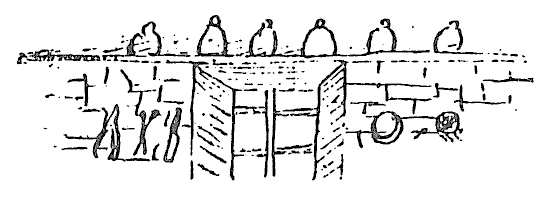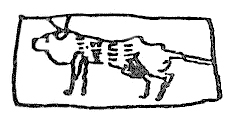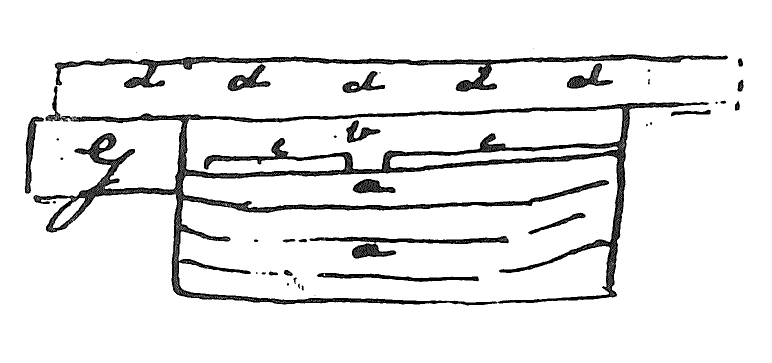From E. A. Darwin 14 November 1822
[Cambridge]
Nov. 14th. 1822.
Dear Bobby.
I am going to honour you again by writing, & first of all, I think it would be an improvement in the Lab:1 to have some more shelves fixed up. The places I have thought of are, 1st. a shelf to go over the window

I have drawn a picture of what I mean, & have put some bottles on the shelf to ornament it.
It is to extend from wall to wall, so that the shelf of ye lamp & also of ye cork bottles must come down NB. the little shelf for ye test glasses may stay up, & if it is possible, let there be one over the door, so as to be a continuation of ye one over the fire place, & if that takes place, the little shelf on which the pounded marble &c is, must also come down, but the little ones above may stay up. Perhaps the shelf over the window had better not be more than a foot wide, otherwise I shall be knocking my head against it.— Get it done as soon as you conveniently can, & pay for it, & I will then have the remainder of ye cow2
 sent up to me, & I will spend it in chemical instruments.— I have ordered a small goniometer (an instrument to measure angles) so that we shall be able to seperate the different crystalls in your cab: I have not yet procured any of the minerals you mentioned. Hensleigh has promised me a bit of asphaltum which he obtained at Teignmouth. I dont think you have any, it is a kind of bitumen very light, will burn, & is of a snuff colour.—
sent up to me, & I will spend it in chemical instruments.— I have ordered a small goniometer (an instrument to measure angles) so that we shall be able to seperate the different crystalls in your cab: I have not yet procured any of the minerals you mentioned. Hensleigh has promised me a bit of asphaltum which he obtained at Teignmouth. I dont think you have any, it is a kind of bitumen very light, will burn, & is of a snuff colour.—
I have bought a book which will be very useful. there are directions for finding out the names of minerals &c. &c. & the rules are not very difficult.—3 I dare say I shall be able obtain some specimens of rocks for you, for Professor Sedgwick4 said that at the Gog Magog hills (about 4 miles distant) there were a vast number of specimens, which I shall certainly some day go & explore.— I am attending Professor Cumming’s5 Lectures on Chemistry which are very entertaining. I have written all his experiments down as far as we have proceded, which we shall be able to try over again This is ye shape of ye Lecture Room

|
aa the seats |
| c.c. 2 large tables | |
| b. ye Lecturer | |
| dddd, a long place like a blacksmith chimney, under wh: are furnaces &c | |
| G. a private room.— |
He has 3 men to assist him so that we get over a good deal of ground in an hour. he lectures every day, all this term. I think my vacation & your holidays will about fit, as my term divided, a few days ago i.e. half the term is over.—
I have just been to chapel, in wh: respect we are better off than you, as we are only obliged to attend 7 times a week. Some evenings preceding Sts days we go to Chapel in surplices, wh: look for all the world like sheets, & indeed one man of St Johns went, for a wager, into chapel dressed in a sheet, & sat before the master without being discovered. I was yesterday matriculated, in wh: you swear that you will not do this & that, wh: one does every day, you swear you wont wear a hat, wont ride, wont play at cricket &c before 12 o clock & half a hundred other things.6 They have affixed a notice, that if you submit yourself humbly after any offence they wont consider you guilty of perjury. I suppose you have heard of black Frank Lightons7 being rusticated. When he came up his Tutor asked him, why he had not read the things he was desired; he answered “why to be frank with you, one gentleman should be frank to another, in the first part of the vacation I was at some very pleasant places and it was impossible quite impossible, you know to read; & in the last, what with shooting & hunting it was impossible”— “Then perhaps Mr Leighton it wont be impossible for you to go down to the country” replied the Tutor, & so down he went.
Give my love to Massie, Pearson, J Lawson,8 & all others. I remain your affectionate brother | E. Darwin. *S 2
Thursday. 14th—
Footnotes
5. 2. 6 44. 17. 6 2 6.
Bibliography
Alum. Cantab.: Alumni Cantabrigienses. A biographical list of all known students, graduates and holders of office at the University of Cambridge, from the earliest times to 1900. Compiled by John Venn and J. A. Venn. 10 vols. Cambridge: Cambridge University Press. 1922–54.
Autobiography: The autobiography of Charles Darwin 1809–1882. With original omissions restored. Edited with appendix and notes by Nora Barlow. London: Collins. 1958.
Henry, William. 1810. The elements of experimental chemistry. 6th ed. 2 vols. London.
Parkes, Samuel. 1806. Chemical catechism for the use of young people: with copious notes for the assistance of the teacher, to which are added a vocabulary of chemical terms, useful tables, and a chapter of amusing experiments. London.
Phillips, William. 1816. Elementary introduction to the knowledge of mineralogy: including some account of mineral elements and constituents; explanations of terms in common use; brief accounts of minerals, and of the places and circumstances in which they are found. Designed for the use of the student. London.
Phillips, William. 1823. Elementary introduction to the knowledge of mineralogy: including some account of mineral elements and constituents; explanations of terms in common use; brief accounts of minerals, and of the places and circumstances in which they are found. Designed for the use of the student. 3d ed. London.
Shrewsbury School register: Shrewsbury School register. 1734–1908. Edited by J. E. Auden. Oswestry: Woodall, Minshall, Thomas and Co., Caxton Press. 1909.
Summary
EAD wants changes made and shelves built to improve the laboratory at the Mount [Darwin residence]; sends drawings and will bring chemical instruments, a book, and his record of experiments done in his chemistry course.
He has now been matriculated.
Letter details
- Letter no.
- DCP-LETT-3
- From
- Erasmus Alvey Darwin
- To
- Charles Robert Darwin
- Sent from
- [Cambridge]
- Postmark
- Cambridge 52
- Source of text
- DAR 204: 3
- Physical description
- ALS 4pp
Please cite as
Darwin Correspondence Project, “Letter no. 3,” accessed on 19 April 2024, https://www.darwinproject.ac.uk/letter/?docId=letters/DCP-LETT-3.xml
Also published in The Correspondence of Charles Darwin, vol. 1


